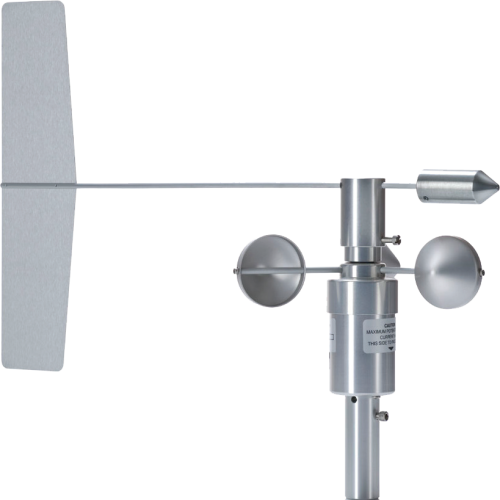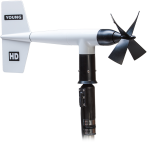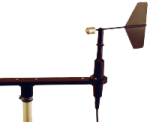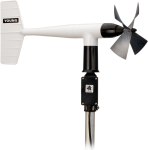This product is not available for new orders.

| Services Available |
|---|
Overview
The 034B, manufactured by Met One, combines a 3-cup anemometer and vane into a single integrated package to measure wind speed and direction. It is cabled for use with our dataloggers, and can provide measurements for a variety of applications.
Read MoreBenefits and Features
- Designed for continuous, long-term, unattended operation in adverse conditions
- Constructed of lightweight aluminum
Images

Similar Products
Detailed Description
The 034B monitors wind speed using a three-cup anemometer that contains a sealed magnetic reed switch. Rotation of the cup wheel produces a pulse that is directly proportional to wind speed. The frequency of the pulse is measured by the datalogger pulse count channel, then converted to engineering units (mph, m/s, knots).
Wind direction is sensed with a potentiometer. With the precision excitation voltage from the datalogger applied to the potentiometer element, the output signal is an analog voltage that is directly proportional to the azimuth of the wind direction.
Compatibility
Mounting
The 034B can be attached to a Campbell Scientific crossarm using a 17953 Nu-Rail fitting or a CM220 Right Angle Mounting Bracket. Alternatively, the 034B can be attached to the top of our stainless-steel tripods via the CM216 Sensor Mounting Kit. The CM216 extends 4 inches above the mast of a CM106B, CM110, CM115, or CM120 tripod.
Data Logger Considerations
The 034B's anemometer uses one pulse count channel on the data logger. Its wind vane requires one single-ended channel and access to an excitation channel (the excitation channel can be shared with other high impedance sensors).
Programming
The 034B's anemometer is measured by the PulseCount Instruction in CRBasic, and by Instruction 3 (Pulse Count) in Edlog. The wind vane is measured by the BrHalf Instruction in CRBasic and by Instruction 4 (Excite-Delay-SE) in Edlog. The measurements are typically processed for output with the Wind Vector instruction (not present in the CR500 or CR9000).
Specifications
| Applications | General (Rain with light snow. Little or now riming or blowing sand. No salt spray.) |
| Sensor | 3-cup anemometer and vane |
| Measurement Description | Wind speed and direction |
| Operating Temperature Range | -30° to +70°C |
| Weight | 907 g (2.0 lb) |
Wind Speed (Anemometer) |
|
| Range | 0 to 75 m/s (0 to 167 mph) |
| Starting Threshold | 0.4 m/s (0.9 mph) |
| Sensor Output | Pulsed contact closure |
| Accuracy |
|
| Resolution | (0.7998 m s–1) / (scan rate in seconds) or (1.789 mph) / (scan rate in seconds) |
| Anemometer Radius | 10.7 cm (4.2 in.) |
| Anemometer Height | 24.4 cm (9.6 in.) |
| Output Signal | Contact closure (reed switch) |
Wind Direction (Vane) |
|
| Mechanical Range | 360° |
| Electrical Range | 356° (4° open) |
| Accuracy | ±4° |
| Damping Ratio | 0.25 |
| Resolution | < 0.5° |
| Potentiometer Resistance | 0 to 10 kΩ (open at crossover) |
| Threshold | 0.4 m s–1 (0.9 mph) |
| Vane Length | 33.5 cm (13.2 in.) |
Documents
Brochures
Manuals
Frequently Asked Questions
Number of FAQs related to 034B-L: 10
Expand AllCollapse All
-
Wind vane tails are user-replaceable and are available for purchase as pn 13765, Replacement Wind Vane Tail for 034B or 034A.
-
For proper siting of the wind sensor, refer to the 034B-L manual. The 034B-L can be mounted using a 1.00 IPS pipe of any length.
-
No. A data logger is needed to measure and store data from the 034B-L.
-
They are completely interchangeable, and no changes are needed.
-
The sensor does not consume power to operate.
-
The 034B-L uses a switch closure for wind speed measurement, and the 03002-L uses a low-level ac output for wind speed measurement. Both use a pulse channel on the data logger to measure wind speed.
-
- Using Short Cut, click the applicable wind direction sensor in the Selected Sensors list of the Outputs screen.
- The two output options enabled are Sample and WindVector. Select WindVector.
- The WindVector instruction has output options. Select an option with mean wind direction in it.
-
The information included on a calibration sheet differs with each sensor. For some sensors, the sheet contains coefficients necessary to program a data logger. For other sensors, the calibration sheet is a pass/fail report.
-
To incorporate a sensor that is compatible with wireless sensor interfaces into a wireless network, a CWS900-series wireless sensor interface is needed, as well as an A205 CWS-to-PC interface to configure it.
Case Studies
The Geography Department at Bucknell University has implemented a weather station to obtain meteorological data......read more










